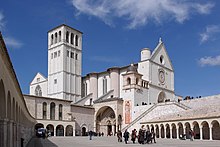| Assisi Assisi | |
 The image of St. Francis The image of St. Francis | |
| Information | |
| Country | Italy |
| Region | Umbria |
| Surface | 186 km² |
| Height | 424 m above sea level |
| Population | 26 179 |
| Area code | 075 |
| website | |
Assisi - a small, medieval, historic town located on the hill of St. Umbria, in the middle Italy.
Assisi is best known as the center of Catholic religious worship (pilgrimage) associated with the founder of the Franciscan order Saint Francis (incl. San Francesco) and st. Klara (incl. Santa Chiara) who were born in Assisi. For tourist reasons, it is worth visiting Assisi for its history, monuments and unique works of art.
In 2000, Assisi was incorporated into UNESCO World Heritage List.
Information
Assisi is a city and commune located southeast of Perugiain the region Umbria, in Perugia Province. St. Francis belongs to The Vatican.
Drive
By plane
It is located 12 kilometers from the town Perugia-Sant'Egidio airport (IATA: PEG, ICAO: LIRZ). It also serves low-cost airlines such as Ryanair (including from Brussels-Charleroi, London-Stanstead, Barcelona-Girona).
By rail
You can get there from the site Rome, Ancona and Florenceto which we travel, e.g. with low-cost airlines.
Coming from Florence towards Rome, get off in Terontola and from there on the Terontola-Foligno route, get off at the station Assisi (Assisi) Santa Maria degli Anieli.
From Rome we travel towards Ancona (and from Ancona towards Rome) and we get off in the village Folignoand from there we take the train to Terontola and get off at Assisi (Assisi) Santa Maria degli Anieli (S.M. A.) The Assisi train station is approx. 3 km from the city center, but by bus line C it is easy to get there.
By car
Assisi is close Perugia, which is the main road junction of this area. Access via the A1 motorway, exit onto the SS75 national road. Then follow the signs that will lead us to the town. You can park in one of the many public car parks located just outside the city walls.
Worth seeing




Assisi is a beautifully situated medieval town, but flooded with crowds of pilgrims and tourists for most of the year. Commercialization and tourist-oriented trash are an inherent attribute of such places, but only when the crowds disappear (later in the evening or off-season) can we fully appreciate the unique atmosphere of picturesque medieval streets and alleys as well as beautifully maintained buildings and structures built of characteristic light stone.
The obligatory list of monuments that every regular tourist "includes" is:
- Number 1 on this list, which is addressed to both pilgrims and art connoisseurs, is undoubtedly St. Francis (inscribed on the UNESCO World Cultural Heritage List). Probably the most important monument in Umbria, where we can find, among others relics of St. Francis and the series of frescoes by Cimabue, Giotto and Pisano. The basilica is divided into the upper church and the lower church. In the upper one we can admire Giotto's frescoes, and in the lower one, which has an amazing atmosphere, Cavallini's frescoes. The remains of St. Francis are in an underground crypt, which, incidentally, was not discovered until 1818.
- Basilica of Santa Maria degli Angeli (Basilica of Our Lady of the Angels) - the cradle of the Franciscan order, rebuilt by St. Francis, the Portiuncula Chapel and the historic monastery
- St. Clara - with the relics of St. Clare and the authentic San Damiano Cross
- St. Rufina - the construction of this Romanesque church began in 1140 under the direction of Jano of Gubio. In the years 1571-1578 the interior of the cathedral was rebuilt, leaving its facade decorated with three rosettes placed over three portals, numerous sculptures and an arcaded frieze. The baptismal font in which St. Francis (at that time it was the only baptismal font in Assisi). St. Rufin. The Chapel of the Blessed Sacrament adjacent to the cathedral is decorated with frescoes by Gioretti, Carboni and Ciro Ferritti.
- Town Hall Square - there was a forum in this place already in antiquity. The temple of Minerva, which was adapted to the Church of Our Lady of Lourdes, comes from this period. Only the facade in the Corinthian order remains of the ancient temple. In the 12th century, the square existed in its present shape. The town hall tower next to the church was built around 1275-1305. Currently, it houses a pinacotheque with works of the Umbrian school from the 12th to 18th centuries.
- Rocca Maggiore Castle - only the ruins of the castle built by the Duke of Spoleto, Konrad of Lützen, have survived. In 1198, the castle was conquered by the rebellious inhabitants of Assisi. It was rebuilt in 1367. Uninhabited since 1538.
work
Science
Shopping
Gastronomy
Festivals, parties
In Assisi, the ecumenical World Days of Prayer for Peace, initiated by Pope John Paul II, take place, hence Assisi is also known as a center of international, religious reconciliation and peace in the world.
Accommodation
contact
Security
Tourist information
Tourist information (Ufficio Informazioni e Accoglienza Turistica- IAT del Comprensorio Assisano)
- Address: Piazza del Comune 06081 Assisi
- Tel .: 0758 138 680/0758138681
- Fax: 0758138686
- E-mail: [email protected]
Where next
There is a hermitage near Assisi (approx. 4 km from the city center) Eremo delle carceri, one of the places where St. Francis and his companions came to pray.
The village of Rivotorto is well worth a visit Franciscan Sanctuary.
| This is outline article. For now, it includes the article schema and not much else. You can help by supplementing the article with at least basic information, making it useful. |

